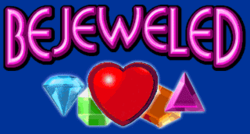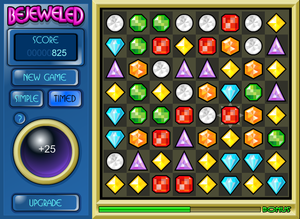m (Add pcgamingwiki link to infobox) |
m (Update guide main page) |
||
| Line 1: | Line 1: | ||
{{Header | {{Header Bar|game=Bejeweled}} | ||
{{Game | {{Game | ||
|completion=2 | |||
|image=Bejeweled logo.png | |||
|title=Bejeweled | |title=Bejeweled | ||
|developer=[[PopCap Games]] | |developer=[[PopCap Games]] | ||
|publisher=[[PopCap Games]] | |publisher=[[PopCap Games]] | ||
| | |year=2001 | ||
|systems=[[Adobe Flash]] | |||
|ratings={{ESRB|E}} | |||
|genre=[[Puzzle]] | |genre=[[Puzzle]] | ||
|modes=[[Single player]] | |modes=[[Single player]] | ||
| | |followed by=[[Bejeweled 2]] | ||
|series=Bejeweled | |series=Bejeweled | ||
| | |seriesDisambig=Bejeweled | ||
|pcgamingwiki=Bejeweled | |pcgamingwiki=Bejeweled | ||
}} | }} | ||
'''Bejeweled''' is the flagship product of [[PopCap Games]] released in [[2001]]. It was the first game in the series of [[puzzle]] games, and influenced the creation of many other match-3 variations. It featured a simple interface, where users click on vertically or horizontally adjacent tiles to swap two gems. | |||
'''Bejeweled''' is the flagship product of [[PopCap Games]] released in [[2001]]. | |||
Bejeweled was influenced by the game [[Shariki]], which used similar mechanics. | Bejeweled was influenced by the game [[Shariki]], which used similar mechanics. | ||
| Line 23: | Line 24: | ||
== Gameplay == | == Gameplay == | ||
[[File:Bejeweled screenshot.png|thumb|right|Gameplay screenshot]] | [[File:Bejeweled screenshot.png|thumb|right|Gameplay screenshot]] | ||
Gems of seven different colors are placed within an 8×8 grid. | Gems of seven different colors are placed within an 8×8 grid. The player must then select two adjacent gems to swap their positions, causing at least one of the formations to create at least three identical gems in a row. Invalid moves that do not create matches cause the gems to return to their original position. | ||
When a match occurs, the gems are destroyed causing gems directly above the removed gems to fall down. | When a match occurs, the gems are destroyed causing gems directly above the removed gems to fall down. Any gems that fall into a 3-in-a-row formation are also removed, with additional points being scored | ||
When you fill the bar at the bottom of the screen, you will receive a bonus; 10 random gems are removed. | When you fill the bar at the bottom of the screen, you will receive a bonus; 10 random gems are removed. The game will become slightly more difficult, whether by providing more difficult gems, or by speeding up the timer. | ||
{{-}} | {{-}} | ||
== Modes == | == Modes == | ||
There are two gameplay modes: | There are two gameplay modes: | ||
;Simple: The objective is to score as many points as possible. | ;Simple: The objective is to score as many points as possible. The game ends when there are no moves remaining. | ||
;Timed: As with simple, you need to score as many points as possible. | ;Timed: As with simple, you need to score as many points as possible. However, there is a timer bar at the bottom that quickly decreases. The game ends when the timer runs out; if there are no available moves, the board is cleared and new gems are placed. | ||
{| {{prettytable}} | {| {{prettytable}} | ||
! Action || Simple || Timed | ! Action || Simple || Timed | ||
| Line 48: | Line 49: | ||
== Tactics == | == Tactics == | ||
The safest option is to clear gems at the top of the grid, and work downwards. | The safest option is to clear gems at the top of the grid, and work downwards. This reserves known matches for the future, when moves become sparse. | ||
Eventually, you will have to create matches at the bottom. | Eventually, you will have to create matches at the bottom. This provides a greater chance of high-scoring cascades, but can also disrupt potential matches in the rows above. | ||
[[Category:PopCap Games]] | [[Category:PopCap Games]] | ||
[[Category:Adobe Flash]] | |||
[[Category:Puzzle]] | |||
[[Category:Single player]] | [[Category:Single player]] | ||
Revision as of 18:46, 21 October 2021
This is the first game in the Bejeweled series. For other games in the series see the Bejeweled category.

| Bejeweled | |
|---|---|
| Developer(s) | PopCap Games |
| Publisher(s) | PopCap Games |
| Year released | 2001 |
| System(s) | Adobe Flash |
| Followed by | Bejeweled 2 |
| Series | Bejeweled |
| Genre(s) | Puzzle |
|---|---|
| Modes | Single player |
| Rating(s) |
Bejeweled is the flagship product of PopCap Games released in 2001. It was the first game in the series of puzzle games, and influenced the creation of many other match-3 variations. It featured a simple interface, where users click on vertically or horizontally adjacent tiles to swap two gems.
Bejeweled was influenced by the game Shariki, which used similar mechanics.
Gameplay

Gems of seven different colors are placed within an 8×8 grid. The player must then select two adjacent gems to swap their positions, causing at least one of the formations to create at least three identical gems in a row. Invalid moves that do not create matches cause the gems to return to their original position.
When a match occurs, the gems are destroyed causing gems directly above the removed gems to fall down. Any gems that fall into a 3-in-a-row formation are also removed, with additional points being scored
When you fill the bar at the bottom of the screen, you will receive a bonus; 10 random gems are removed. The game will become slightly more difficult, whether by providing more difficult gems, or by speeding up the timer.
Modes
There are two gameplay modes:
- Simple
- The objective is to score as many points as possible. The game ends when there are no moves remaining.
- Timed
- As with simple, you need to score as many points as possible. However, there is a timer bar at the bottom that quickly decreases. The game ends when the timer runs out; if there are no available moves, the board is cleared and new gems are placed.
| Action | Simple | Timed |
|---|---|---|
| Matching 3 | 10 + 5/level | 20 + 5/level |
| Matching 4 | 20 + 10/level | 40 + 10/level |
| Matching 5 | 30 + 15/level | 60 + 15/level |
| End of level bonus | 10 + 10/level per gem (10 gems) | 15 + 15/level per gem (10 gems) |
Tactics
The safest option is to clear gems at the top of the grid, and work downwards. This reserves known matches for the future, when moves become sparse.
Eventually, you will have to create matches at the bottom. This provides a greater chance of high-scoring cascades, but can also disrupt potential matches in the rows above.